+ Open data
Open data
- Basic information
Basic information
| Entry | Database: PDB / ID: 7l6k | ||||||
|---|---|---|---|---|---|---|---|
| Title | ApoL1 N-terminal domain | ||||||
 Components Components | Apolipoprotein L1 | ||||||
 Keywords Keywords | MEMBRANE PROTEIN / Ion channel / kidney disease / lipoprotein | ||||||
| Function / homology |  Function and homology information Function and homology informationlipoprotein metabolic process / high-density lipoprotein particle / very-low-density lipoprotein particle / cytolysis by host of symbiont cells / lipid transport / chloride channel activity / Scavenging of heme from plasma / cholesterol metabolic process / chloride transmembrane transport / Post-translational protein phosphorylation ...lipoprotein metabolic process / high-density lipoprotein particle / very-low-density lipoprotein particle / cytolysis by host of symbiont cells / lipid transport / chloride channel activity / Scavenging of heme from plasma / cholesterol metabolic process / chloride transmembrane transport / Post-translational protein phosphorylation / Regulation of Insulin-like Growth Factor (IGF) transport and uptake by Insulin-like Growth Factor Binding Proteins (IGFBPs) / blood microparticle / endoplasmic reticulum lumen / innate immune response / lipid binding / extracellular space / extracellular region / membrane Similarity search - Function | ||||||
| Biological species |  Homo sapiens (human) Homo sapiens (human) | ||||||
| Method | SOLUTION NMR / simulated annealing | ||||||
 Authors Authors | Holliday, M.J. / Ultsch, M. / Moran, P. / Fairbrother, W.J. / Kirchhofer, D. | ||||||
 Citation Citation |  Journal: Commun Biol / Year: 2021 Journal: Commun Biol / Year: 2021Title: Structures of the ApoL1 and ApoL2 N-terminal domains reveal a non-classical four-helix bundle motif. Authors: Ultsch, M. / Holliday, M.J. / Gerhardy, S. / Moran, P. / Scales, S.J. / Gupta, N. / Oltrabella, F. / Chiu, C. / Fairbrother, W. / Eigenbrot, C. / Kirchhofer, D. | ||||||
| History |
|
- Structure visualization
Structure visualization
| Structure viewer | Molecule:  Molmil Molmil Jmol/JSmol Jmol/JSmol |
|---|
- Downloads & links
Downloads & links
- Download
Download
| PDBx/mmCIF format |  7l6k.cif.gz 7l6k.cif.gz | 839.8 KB | Display |  PDBx/mmCIF format PDBx/mmCIF format |
|---|---|---|---|---|
| PDB format |  pdb7l6k.ent.gz pdb7l6k.ent.gz | 714.3 KB | Display |  PDB format PDB format |
| PDBx/mmJSON format |  7l6k.json.gz 7l6k.json.gz | Tree view |  PDBx/mmJSON format PDBx/mmJSON format | |
| Others |  Other downloads Other downloads |
-Validation report
| Summary document |  7l6k_validation.pdf.gz 7l6k_validation.pdf.gz | 539.3 KB | Display |  wwPDB validaton report wwPDB validaton report |
|---|---|---|---|---|
| Full document |  7l6k_full_validation.pdf.gz 7l6k_full_validation.pdf.gz | 772.8 KB | Display | |
| Data in XML |  7l6k_validation.xml.gz 7l6k_validation.xml.gz | 51 KB | Display | |
| Data in CIF |  7l6k_validation.cif.gz 7l6k_validation.cif.gz | 75 KB | Display | |
| Arichive directory |  https://data.pdbj.org/pub/pdb/validation_reports/l6/7l6k https://data.pdbj.org/pub/pdb/validation_reports/l6/7l6k ftp://data.pdbj.org/pub/pdb/validation_reports/l6/7l6k ftp://data.pdbj.org/pub/pdb/validation_reports/l6/7l6k | HTTPS FTP |
-Related structure data
| Related structure data |  7lf7C 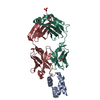 7lf8C  7lfaC  7lfbC  7lfdC C: citing same article ( |
|---|---|
| Similar structure data | |
| Other databases |
|
- Links
Links
- Assembly
Assembly
| Deposited unit | 
| |||||||||
|---|---|---|---|---|---|---|---|---|---|---|
| 1 |
| |||||||||
| NMR ensembles |
|
- Components
Components
| #1: Protein | Mass: 13309.070 Da / Num. of mol.: 1 / Fragment: residues 61-172 Source method: isolated from a genetically manipulated source Source: (gene. exp.)  Homo sapiens (human) / Gene: APOL1, APOL / Production host: Homo sapiens (human) / Gene: APOL1, APOL / Production host:  |
|---|
-Experimental details
-Experiment
| Experiment | Method: SOLUTION NMR | ||||||||||||||||||||||||||||||||||||||||||||||||||||||||||||||||||||||||||||||||||||||||||||||||
|---|---|---|---|---|---|---|---|---|---|---|---|---|---|---|---|---|---|---|---|---|---|---|---|---|---|---|---|---|---|---|---|---|---|---|---|---|---|---|---|---|---|---|---|---|---|---|---|---|---|---|---|---|---|---|---|---|---|---|---|---|---|---|---|---|---|---|---|---|---|---|---|---|---|---|---|---|---|---|---|---|---|---|---|---|---|---|---|---|---|---|---|---|---|---|---|---|---|
| NMR experiment |
|
- Sample preparation
Sample preparation
| Details | Type: solution Contents: 0.9 mM [U-99% 13C; U-99% 15N] ApoL1 (61-172), 93% H2O/7% D2O Details: 0.9 mM 13C15N APOL1 61-172 / Label: 13C15N_sample / Solvent system: 93% H2O/7% D2O |
|---|---|
| Sample | Conc.: 0.9 mM / Component: ApoL1 (61-172) / Isotopic labeling: [U-99% 13C; U-99% 15N] |
| Sample conditions | Details: 25 mM MES, 25 mM NaCl, 1 mM EDTA, pH 5.5 / Ionic strength: 50 mM / Label: conditions_1 / pH: 5.5 / Pressure: 1 atm / Temperature: 310 K |
-NMR measurement
| NMR spectrometer |
|
|---|
- Processing
Processing
| NMR software |
| ||||||||||||||||||||
|---|---|---|---|---|---|---|---|---|---|---|---|---|---|---|---|---|---|---|---|---|---|
| Refinement |
| ||||||||||||||||||||
| NMR representative | Selection criteria: lowest energy | ||||||||||||||||||||
| NMR ensemble | Conformer selection criteria: structures with the lowest energy Conformers calculated total number: 100 / Conformers submitted total number: 20 |
 Movie
Movie Controller
Controller



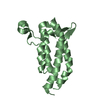
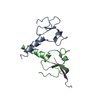
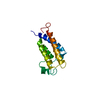
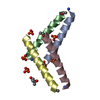
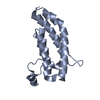
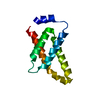
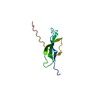
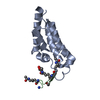
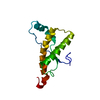
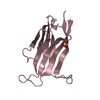
 PDBj
PDBj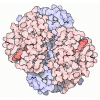





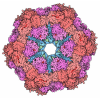




 gel filtration
gel filtration